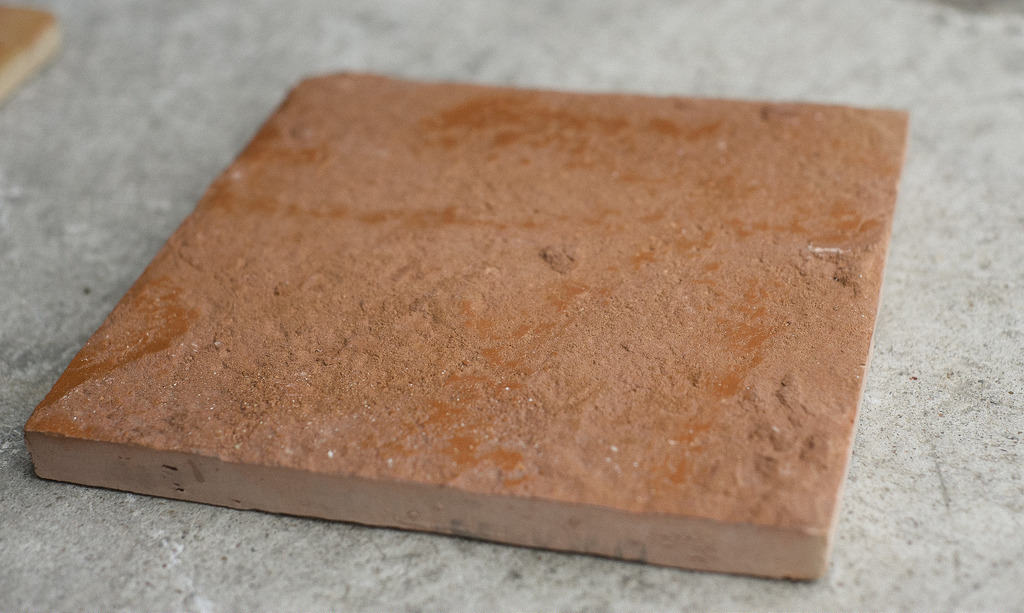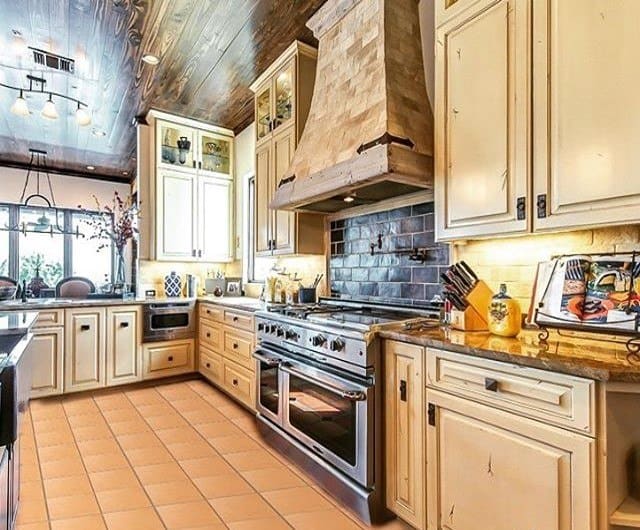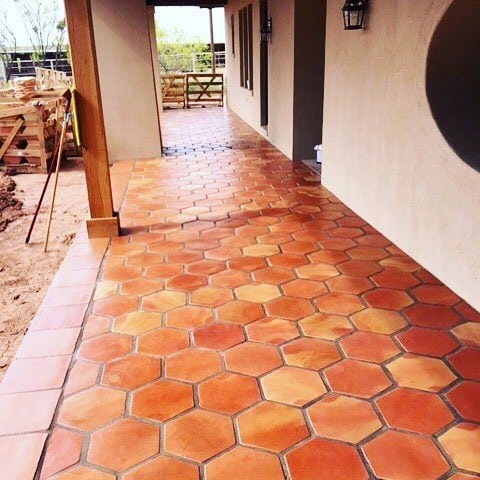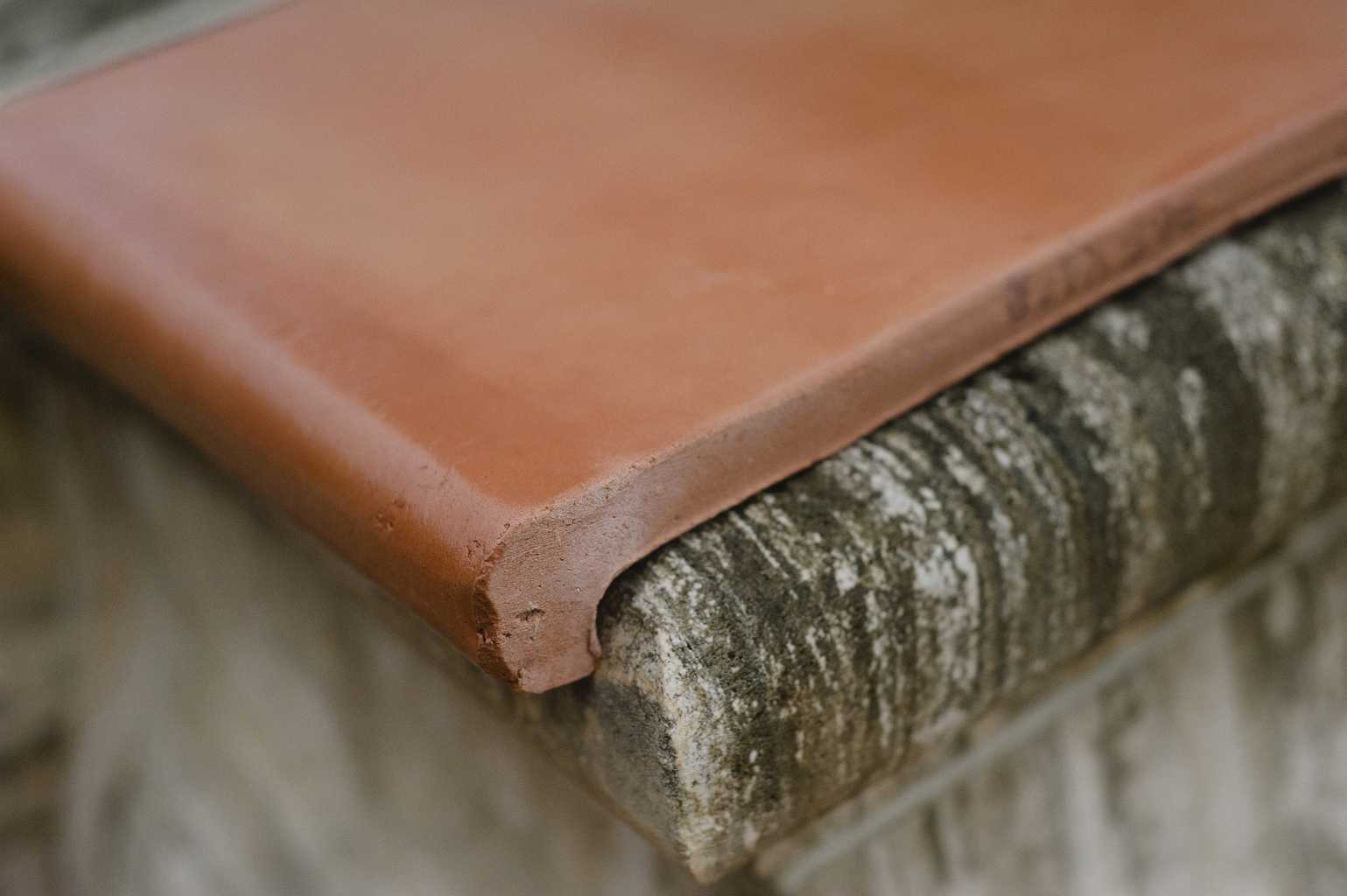Saltillo Mexican tile has been used in homes in Central and South America for hundreds of years. Though not durable enough to withstand harsh winters outside, these tiles are lovely indoors anywhere. The challenges of this type of flooring include installation of Saltillo tile, restoration of Saltillo tile, and maintaining Saltillo tile. But the benefits — rustic beauty, non-toxic materials used to manufacture, and low cost — may outweigh any drawbacks.
Bring the beauty and peace of Mexico to your home with Saltillo floor tiles. When paired with the right décor, Saltillo tile can have a bit of an exotic feel. It also makes for great solar mass for homes using passive solar energy!
Many choose Saltillo tile due to the:
- Natural beauty of the tiles themselves.
- The non-toxic materials used to manufacture the tiles.
- The low-cost of the tiles for the high end look.
Saltillo tile has its challenges, which include:
- The tiles themselves are extremely fragile.
- Maintaining and cleaning the tiles is tedious.

(Photo credit: Rustico Tile and Stone)
What is Saltillo Tile?
Saltillo tile is a type of terra-cotta tile made only in northern Mexico. These tiles are made of natural clay that is first shaped by hand and then dried in the sun. Saltillo tiles are then kiln fired to ensure hardness and durability. The tiles are carefully positioned in the kiln in order to create different colors. Depending on the tile position in the kiln, the resulting tiles can range in hue from pale amber to dark terra-cotta. Traditionally, Saltillo tiles are left unglazed, although some manufacturers sell them pre-treated or pre-sealed in order to increase their durability.
Naturally, Saltillo tile is not terribly strong or hard. Although it is comparable to other natural stone tiles (such as slate or granite) it can chip and crack. When used as exterior tiling, it can only be used in very mild climates, as harsh weather can damage the tile. Really, Saltillo tile should not even be used indoors in places that are particularly cold, as they will not be able to hold up in the face of colder temperatures. Saltillo tile typically has a MOH (measure of hardness rating) between a 3 and 4, which is fairly low (compare to porcelain, which has an average MOH of 7-9). Therefore, it is very rarely used for outdoor purposes these days, though it very warm climates, well maintained and sealed Saltillo tile makes for a nice tile flooring option for a patio. However, the elegance and beauty Saltillo Tile brings to the interior of the home more than makes up for its lack of strength and hardness.

(Photo credit: Rustico Tile and Stone)
Installing Saltillo Tiles
Installing Saltillo tile also has to be done carefully, as the tiles are delicate. Any grout or chemicals spilled on the tiles can damage them, so it is crucial to keep the tiles covered with paper until the installation is complete. This is not typically something that you will want to attempt yourself unless you have a good bit of experience with tile installation and feel confident with your abilities. However, because individual Saltillo tiles are so inexpensive, you can take a little liberty and losing one or two tiles during installation will not obliterate your flooring budget.
Prior to starting installation, you will need to make sure the subfloor is perfectly prepared. The flooring must be perfectly level and there are no cracks, holes or misalignments where moisture can get trapped. The tiles can be laid starting in one corner of the room or starting from the middle of the room, but the last row of tiles will need to be cut carefully to fit. Once the tiles have all been laid, a sealer will need to be applied, then a grout, and finally at least a second layer of the sealer.

Sealing Saltillo Tiles
Saltillo tile was introduced to Mexico by Spaniards hundreds of years ago, and the process of making the tile has remained the same since. The tile is actually named after the Mexican town of Saltillo, which produces the right clay and weather for making this popular tile.
As Saltillo tiles are fired at such low temperatures, they remain very porous and are therefore very susceptible to water damage. It is almost exclusively recommended these days that you seal Saltillo tiles to protect them from water, wear, and scratches. Typically, Saltillo tiles should be sealed after they have been installed and are completely dried and clear of extra dirt and debris. You will want to decide primarily how much shine you are wanting from your floors and choose a level of gloss or matte for the sealant and polish appropriately. Sealant should be applied in several coats, and the number of coats can vary depending on the manufacturer’s recommendation.
Maintaining Saltillo Tiles In the Home
Saltillo tile in the home has a few drawbacks. Regular sweeping is one of the best ways to maintain the Saltillo tiles in your home. While some recommend vacuuming, regular vacuuming could chip the tile, which is why sweeping is really the preferred method for daily maintenance. For a deeper cleaning, unsealed and untreated tile needs to be laboriously cleaned with diluted ammonia and “elbow grease”, and lots of rinsing. Saltillo tile floors need stripping and resealing, before and after cleaning to do a proper job. It is important to also wipe up any spills and dirt right away, as the tiles can stain. If the floor is ever flooded, the delicate tiles will be severely weakened. Only slightly damp mops can be used on the floors, and only the very mildest cleansers (no harsh chemicals). Also, a sealant will have to be reapplied regularly to keep the floor in good condition.

(Photo credit: Rustico Tile and Stone)
If you are planning to refinish Saltillo tiles, you will need to make sure any previous polish or sealant has been completely stripped and all that remains is the basic Saltillo tiles. To strip the tiles, you should use a gentle solvent and a soft bristle brush to prevent damage to the tiles themselves. Also, when refinishing, a new grout will have to be applied along with the new sealant.
Why Choose Saltillo Tile
Despite these disadvantages, there are many benefits to selecting Saltillo tile for your flooring needs. Primarily, Saltillo Mexican tile is beautiful and offers design flexibility. Whether you have a modern home, a country French-style residence, or love the Mediterranean style, the natural beauty of Saltillo tile can make your home truly stand out. Although this tile requires a little more effort to care for, many homeowners and decorators feel that it is well worth it for the beauty it brings to any room. Modern sealants do make cleaning and caring for Saltillo tile easier than ever before. The tile itself is comparatively inexpensive and many homeowners like the all-natural products that go into the tile-making process. At a time when we are surrounded by chemicals, it is nice to bring a natural product into the home.
The greatest benefit to Saltillo tile is that, because it is inexpensive, people feel free to experiment with various patterns and designs with the tiles and the results can be truly unique and spectacular. The tiles are readily available via almost all leading suppliers and, therefore, sourcing the product is not difficult at all. There are even blogs dedicated to various Saltillo designs where you can find inspiration and demonstrations of a whole selection of incredible designs. Perusing these visual examples can give you a clear idea as to how you want your flooring to look. If you need further or more specific advice, your Saltillo tile supplier will be able to recommend a few experts who can help you make your choices.

(Photo credit: Rustico Tile and Stone)
In general, natural tile flooring is a beautiful and durable flooring option for your home. If you’re looking for advice on specific tile flooring options, most popular professional companies, such as Lumber Liquidators, are happy to provide information regarding specific tile flooring options or installation and will even do in-home consultations at no charge. If you want a naturally beautiful and affordable flooring solution, consider installing Saltillo tile in your home. It has been trusted by savvy homeowners for hundreds of years. Is it time for you to trust too?

Flooring Lady:
Where/can I obtain an 8″ Saltillo tile in a matte, or flat finish?
Thanks!
Hi Chuck,
Have you tried doing a google search? You’ll be able to find Saltillo manufacturers that way. Their websites will show the products they make and often have links for their retailers.
I installed Satillo tile on a covered porch three years ago. It still looks fine except for 2 places where oil leaked onto the floor. What would be the best way to clean the stains? I can tell the oil soaked into the tile. Is there a product that works best? Thanks in advance.
Go to http://www.aquamix.com and look in their Saltillo section. There are a couple different products/methods you can try. I’m not saying that you have to use their products. They’re great products though, and their website does an excellent job of explaining the uses of each product.
After getting the oil up, make sure your tile is sealed – and sealed well. Sounds like it isn’t if oil penetrated the tile.
I live in the northeast and stored my cartons of newly purchased saltillo tiles on my porch through cold weather. I am finally ready to have them installed but now am concerned that they may have been damaged by the cold. What kind of damage should I be looking for? How can I tell if they are ok?
thanks
Hi Arlene,
They should be fine – they’re pretty tough! So long as they aren’t cracking, chipping, or flaking you should be fine. Don’t forget to read about how to install and seal them properly – that’s one of the biggest mistakes people make!
Hello! Am considering placing saltillo tile in a small, front entry/patio area. Is it realistic to set the square saltillo floor tiles like pavers? Can they be placed on a barrier sheet without adhesive and then just sand-filled instead of grouted? What type of sealer should be used? Other than a natural arbor growing on lattice, this is an outdoor, non-covered area.
Hi Victoria,
Will saltillo is beautiful, it really needs to be grouted in. Be sure to seal the tiles first, then seal again after grouting 9cleaning up the excess grout obviously). Water will seep into saltillo and ruin it. Sealer will only last so long, I doubt you’d want to mess with taking it all up every 2 or 3 years and starting over. I can recommend AquaMix products for Saltillo – I’ve been very pleased with them. (www.aquamix.com)
hi,
2 years ago we moved into a home in texas, with an outdoor patio floored with saltillo tile. back then we cleaned it with deluted bleach and the power washer like the people that lived there before us told us they had done. everything was fine it looked as good as new. after the last 6 months of bad weather and 2 floods later, we had someone else clean the tile the same way we had done before but this time all the tile turned white and crystals formed on top of it. is there anything we can do to save our patio and restore the color to the saltillo tile?
I don’t understand all the warnings regarding problems with satillo. I knew nothing about these problems or special installation instructions twenty years ago when I installed about 850 sq. ft. of 10X10 saltillo floor tile. It looks just as it did after installation except for a couple scratches near my fridge. I sealed the tile before installation and waxed them afterward. I’ve waxed them twice since. Nothing else.
My question is, where can I find about 80 pc. to fill in areas after my kitchen remodel? That’s right, this floor is outlasting my kitchen! It’s the main reason I love this floor. It wears like iron. I’ve found 12X12 and 8X8 but not 10X10. Actual size is 10 3/16″ square, on back, 10″square between visible grout on floor. I have two original boxes left. Printed on the boxes is the city name Guadalajara Jalisco. Any help is greatly appreciated, thank you.
Scott
Hi Flooring Lady, Am I glad we found you. We bought a house that has saltillo tiles (I think they are called) in the kitchen. We found extra tiles in the garage and they are unglazed so we are assuming these in the kitchen were unglazed when installed. Previous owners left “P26 Preserving Fluid for Terra Cotta” and “Terra Cotta Wax.” We also bought a contains of HMK R80 Stripper/stain remover but haven’t used it yet as we are concerned about doing anything to damage the tiles. The floors desperately need thorough cleaning. We’ve used vinegar solution to scrub them and they still look dirty. What should be do?
Hi Annette,
It sounds like much of the sealer (preserving fluid) is worn away and probably needs stripped and resealed. Be sure to look through the other comments associated with this article here. You’ll find everything you ever wanted to know about Saltillo floor care…… and then some. ;o)
Hi Scott –
It sounds like you were very lucky — apparently the installer knew how to lay these tiles and some good products to use. Saltillo is wonderfully durable and will look great for a long time (even centuries!!) if done right. Unfortunately, it often isn’t installed right and even more often, the correct products aren’t used on it (or enough of the correct product!).
I did find some good links for buying Mexican tile and Saltillo tile. Maybe one of these can help:
http://www.artesanos.com/tile_saltillo.html (they do carry 10×10)
http://terracottacorp.com/terra-mexican-tiles.asp?gclid=CNSgjqzetJoCFSMgDQodm11vbw
http://www.mexitraditions.com/
http://www.saltillotileconnection.com/
http://www.saltillotileconnection.com/saltillo/
http://www.mexicantiles.com/talavera-ceramic-tile.html?gclid=CO3G3r_etJoCFR7yDAodIFPCdQ
I found them doing a google search
we moved to a home with saltillo tile floors. they have either faded or something else discolored them. they were sealed, but….. . can they be removed to replace? or can they be sanded and restored? any information will be helpful. thanks.
I have installed Saltillo tiles on my back patio floor. My grandkids have spilled oily sunscreen on a few tiles and have stained them,, how can I remove the sunscreen from the tile and bring the beauty of the tile back? it just looks dirty all the time.. Thank you for whatever advise you can give. Tile is only 2 years old,, disgusted in los angeles
Hi Pat,
Yes, they can be removed and replaced with new tiles. I wouldn’t recommend sanding, but you can of course try it – it’s no big loss if it doesn’t work out since you’ll then be replacing it. Remember though, Saltillo comes in many colors, are you sure that they’re discolored?
Hi Carlos,
Go to http://www.aquamix.com and look at their products for Saltillo. There are actually a couple different ones that should work to get the sunscreen out of the tiles. It doesn’t sound like the tiles were sealed well, if at all. Sealing them is so very important in order to protect the tiles from accidents such as this.
When the tile guys installed our saltillo tile they didn’t clean up the glue from some of the tiles. They used Goo-Gone but it didn’t get up all the sticky stuff. We’ve worked on it with Goo-Gone too but can’t get up the last bit of glue. What can we do about it?
Hi Gayle,
Were the floors sealed afterward? If so, then the last bit of glue is actually under the sealer and cannot be removed without stripping. I would suggest giving the installers a call and insisting that this mess be cleaned up properly – even if it means stripping the floor and resealing to do so. If they don’t want to do this to make their customer happy, then take lots of pics, get estimates from other tilers/contractors and take the installers to small claims court.
If you decide you want to do this yourself, look at the saltillo floor care products at aquamix.com so you can see what you will be needing to buy. Strippers and sealers are not cheap and if you go this route, please educate yourself before you tackle the job so that you can do a better job than these ‘pros’.
Thanks for your answer and advice. Yes, they had sealed it. I will call the contractor and talk to him about it. I appreciate your answer.
Gayle